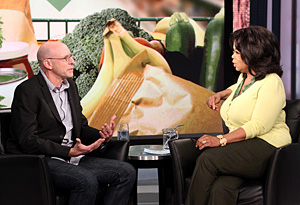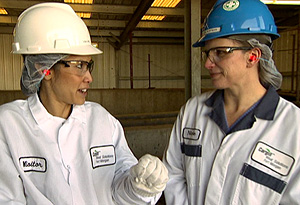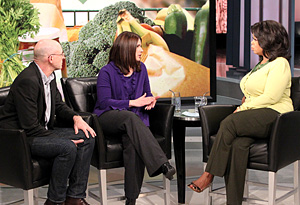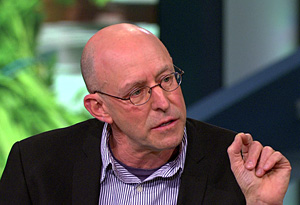Do You Know Where Your Food Comes From?

Nobody gets us thinking more about what we eat than Michael Pollan does. For the past 25 years, the best-selling author has been opening our eyes to food with books like The Omnivore’s Dilemma: A Natural History of Four Meals and Food Rules: An Eater's Manual. Last year, he was named one of Time magazine's 100 Most Influential People in the world. Michael's message is that we're not going to get right with how we eat until we start thinking about where our food comes from.
"It's all opaque. You go to the grocery store and the meat doesn't even have bones anymore. It's just shrink-wrapped protoplasm, and kids don't even know that it comes from an animal and that the animal had to be killed in order to put it on your plate," Michael says.
"It's all opaque. You go to the grocery store and the meat doesn't even have bones anymore. It's just shrink-wrapped protoplasm, and kids don't even know that it comes from an animal and that the animal had to be killed in order to put it on your plate," Michael says.

We have more access to food than ever before, but Michael says the American diet has become a catastrophe. "Seventy-five percent of our healthcare spending is on chronic diseases linked to diet. That's really bankrupting us, and that has to do with the way we're eating," he says.
It's not just the high amount of calories we're consuming that are hurting us. Michael says it's also the types of foods we're eating—like processed foods and refined carbohydrates.
"Our diet has changed more in the last 100 years than in the last 10,000, probably with the result that it is affecting our health," Michael says.
It's not just the high amount of calories we're consuming that are hurting us. Michael says it's also the types of foods we're eating—like processed foods and refined carbohydrates.
"Our diet has changed more in the last 100 years than in the last 10,000, probably with the result that it is affecting our health," Michael says.

According to the U.S. Department of Agriculture, Americans eat nearly 10 billion animals a year, including 33 million cows. If you make the choice to eat meat, Michael says you should know how it's produced. To get the inside scoop, Lisa Ling travels to Colorado, where Cargill, the biggest producer of ground beef in the world, gives her a rare inside look at how our meat is made.
Go inside a meat processing plant with Lisa
Lisa's trip starts with a visit to a feed lot, where as many as 12,000 cattle are in the process of being fattened up. The cattle stay on the feed lot for around 200 days and gain about three pounds a day from a highly concentrated diet of corn and corn byproduct. Afterward, Lisa is taken to the Cargill processing plant and meets General Manager Nicole Johnson-Hoffman. Nicole tells her that they bring in 4,500 animals a day, which arrive in about 140 different truckloads of cattle.
Upon arrival, the cattle are held in pens for two hours to calm them before they're sent to be slaughtered. Each cow is then shot in the head with a bolt, which renders it insensible to pain. The cow's artery is then cut, and about two minutes later, it dies from blood loss. After the animal's death, the body is immediately washed, the skin is removed, and within minutes, the workers also remove the hooves, the hide and the head. The carcass is then moved to a giant cooler, where it stays for up to two days. After it's been inspected and graded, it's packaged, loaded on trucks and soon ends up in our local restaurants and stores.
Go inside a meat processing plant with Lisa
Lisa's trip starts with a visit to a feed lot, where as many as 12,000 cattle are in the process of being fattened up. The cattle stay on the feed lot for around 200 days and gain about three pounds a day from a highly concentrated diet of corn and corn byproduct. Afterward, Lisa is taken to the Cargill processing plant and meets General Manager Nicole Johnson-Hoffman. Nicole tells her that they bring in 4,500 animals a day, which arrive in about 140 different truckloads of cattle.
Upon arrival, the cattle are held in pens for two hours to calm them before they're sent to be slaughtered. Each cow is then shot in the head with a bolt, which renders it insensible to pain. The cow's artery is then cut, and about two minutes later, it dies from blood loss. After the animal's death, the body is immediately washed, the skin is removed, and within minutes, the workers also remove the hooves, the hide and the head. The carcass is then moved to a giant cooler, where it stays for up to two days. After it's been inspected and graded, it's packaged, loaded on trucks and soon ends up in our local restaurants and stores.

After her tour, Lisa says she still eats meat but has a new appreciation for where it comes from. Nicole says she was happy to have Lisa at the plant, because she thinks people should know where their food is coming from. "I would not ridicule people who believe that you shouldn't eat animals, but I would say that we are committed to doing it right. And I believe that when animals are handled with dignity and harvested carefully, that's the natural order of things," says Nicole.
Nicole says the animal's dignity is something they take very seriously. When the animal is shot with the bolt, they make sure it's done in a way that doesn't startle them. "It's critical not to spook them. They are kept quiet on purpose. It gives them a peaceful end of life, and it's also important for the quality of the product that we produce."
Whether you eat meat or not, Nicole thinks everyone who's interested in the American food system can work together to create better results. "I think we're all on the same path trying to figure out the right way to get to good health for our families and environmental sustainability and humane treatment," she says. "We'll find a better result together, even if we have perhaps different perspectives or different beliefs."
Nicole says the animal's dignity is something they take very seriously. When the animal is shot with the bolt, they make sure it's done in a way that doesn't startle them. "It's critical not to spook them. They are kept quiet on purpose. It gives them a peaceful end of life, and it's also important for the quality of the product that we produce."
Whether you eat meat or not, Nicole thinks everyone who's interested in the American food system can work together to create better results. "I think we're all on the same path trying to figure out the right way to get to good health for our families and environmental sustainability and humane treatment," she says. "We'll find a better result together, even if we have perhaps different perspectives or different beliefs."

Michael says eating meat has become a hot-button issue in our country because many people are big meat eaters. "To say that you shouldn't eat meat is a moral challenge, it's an ethical challenge and it's a challenge to your tradition," he says.
Michael says there are many good reasons to reduce your consumption of meat, but to eliminate it from your diet or not is a personal choice. For himself, Michael's chosen to eat meat a couple times a week—a decision he says he's very happy with. "[I thought about if I should eat meat or not] and I came out thinking I could eat meat in this very limited way from farmers who were growing it in a way that I could feel good about how the animals lived," Michael says. "And luckily, we have a great many farmers like this now. We have a renaissance of small animal farming, and we're not feeding them grain and taking the grain away from people who need that food."
While he doesn't think there's anything wrong with eating meat, he does believe we have to start thinking about the way it's being made and how it's affecting the environment, the animals and the workers in the factories. "There are great farmers in this country who are doing really good work, and they need to be supported," says Michael. "We need to reform the meat system—not eliminate it."
Michael says there are many good reasons to reduce your consumption of meat, but to eliminate it from your diet or not is a personal choice. For himself, Michael's chosen to eat meat a couple times a week—a decision he says he's very happy with. "[I thought about if I should eat meat or not] and I came out thinking I could eat meat in this very limited way from farmers who were growing it in a way that I could feel good about how the animals lived," Michael says. "And luckily, we have a great many farmers like this now. We have a renaissance of small animal farming, and we're not feeding them grain and taking the grain away from people who need that food."
While he doesn't think there's anything wrong with eating meat, he does believe we have to start thinking about the way it's being made and how it's affecting the environment, the animals and the workers in the factories. "There are great farmers in this country who are doing really good work, and they need to be supported," says Michael. "We need to reform the meat system—not eliminate it."



